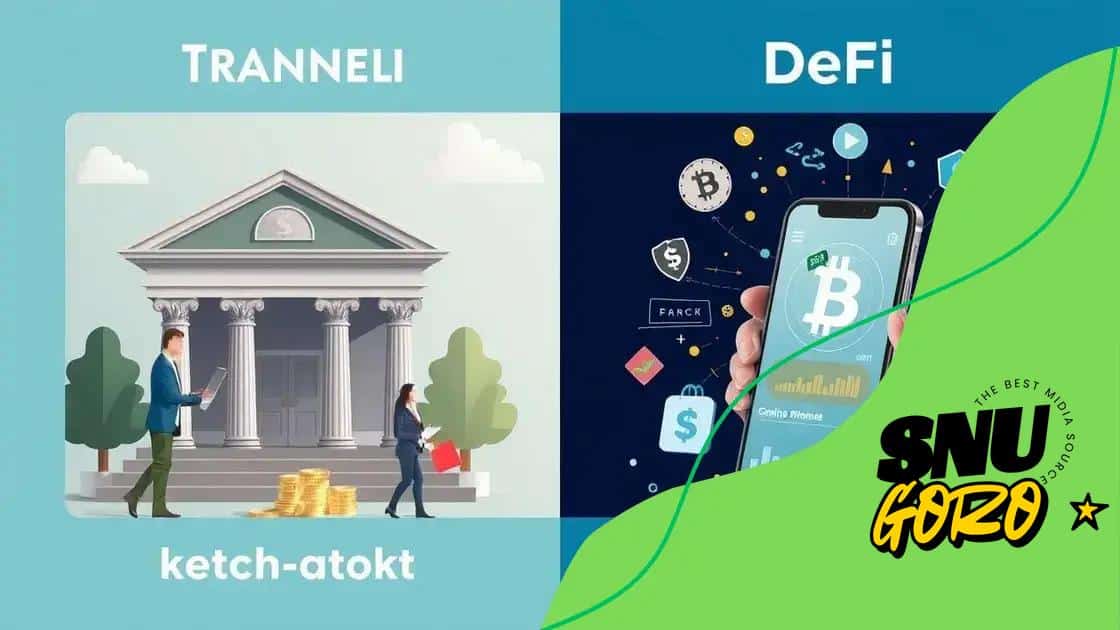Decentralized finance (DeFi) adoption challenges you should know

Decentralized finance (DeFi) adoption challenges include security vulnerabilities, regulatory uncertainty, and technological complexities that can hinder user participation and slow down the growth of this innovative financial sector.
Decentralized finance (DeFi) adoption challenges present significant hurdles for investors and developers alike. Have you ever wondered what stands in the way of wider cryptocurrency and DeFi mainstream acceptance? Let’s dive in and explore these challenges one by one.
Understanding decentralized finance (DeFi)
Understanding decentralized finance (DeFi) is crucial for anyone looking to navigate the evolving landscape of finance. DeFi leverages blockchain technology to offer financial services without traditional intermediaries like banks. This innovative approach is changing how we think about money and transactions.
At its core, DeFi aims to provide greater access to financial services for everyone. Traditional finance often excludes many people due to high fees and strict regulations. With DeFi, anyone with an internet connection can participate. This opens up new opportunities and can lead to financial empowerment.
Key Features of DeFi
DeFi platforms are built on smart contracts, which are self-executing contracts with the terms of the agreement directly written into code. Here are some key features:
- Accessibility: No middlemen means lower costs and greater inclusivity.
- Transparency: Transactions are recorded on public blockchains, allowing anyone to verify them.
- Security: Users maintain control of their assets with secure wallets.
- Innovative Financial Products: DeFi offers lending, borrowing, and staking opportunities.
The flexibility of DeFi protocols is another compelling aspect. Developers can create a wide range of applications for various financial purposes. From decentralized exchanges (DEXs) to lending platforms, the possibilities seem endless.
However, it’s essential to understand the potential risks involved. The decentralized nature of DeFi can lead to vulnerabilities, such as smart contract bugs or security breaches. It is vital for users to conduct thorough research before engaging with DeFi products.
In summary, understanding decentralized finance (DeFi) involves recognizing its potential benefits and risks. This emerging sector is reshaping the financial landscape, making it more accessible and innovative for everyone.
Key barriers to DeFi adoption
Key barriers to DeFi adoption highlight the challenges facing this innovative financial sector. Understanding these barriers is essential as they impact both new users and developers. While DeFi offers exciting opportunities, there are significant hurdles that must be addressed.
Security concerns stand out as a major barrier. Many potential users are wary of the risks associated with smart contracts. These contracts can contain bugs or vulnerabilities that may lead to losses. Educating users about security measures is crucial to build trust.
Regulatory Uncertainty
The lack of clear regulations also hampers DeFi adoption. Different countries have varying approaches to cryptocurrency and DeFi. This inconsistency can deter users from engaging fully with DeFi platforms.
- Inconsistent global regulations: Varied rules create confusion.
- Fear of legal repercussions: Users may worry about the legality of their actions.
- Limited guidance for developers: Uncertain regulatory environments can stifle innovation.
Another barrier is the steep learning curve associated with using DeFi platforms. Many users find the technology complex and overwhelming. Simplifying user interfaces and providing educational resources can help bridge this gap.
Additionally, liquidity issues can pose challenges for new projects. If there isn’t enough liquidity, users may struggle to execute trades efficiently. This issue can lead to higher costs for transactions and discourage participation.
In essence, while key barriers to DeFi adoption exist, addressing them through education, regulatory clarity, and improved platforms can pave the way for broader acceptance and engagement within the decentralized finance space.
Comparing DeFi and traditional finance

Comparing DeFi and traditional finance helps us understand the advantages and disadvantages of both systems. Traditional finance has been the norm for centuries, characterized by established banks and intermediaries. In contrast, decentralized finance offers a revolutionary approach that changes how financial transactions occur.
One of the key differences lies in control. In traditional finance, banks and financial institutions hold power over transactions and customer data. Users must trust these institutions to keep their money secure. In DeFi, individuals have full control over their assets, using blockchain technology to manage their finances without intermediaries.
Accessibility
Accessibility is another major point of comparison. Traditional finance often excludes individuals without bank accounts or those facing high fees. DeFi platforms allow anyone with an internet connection to participate. This opens doors to underbanked populations and provides new financial opportunities.
- Low entry barriers: No need for credit checks.
- Global reach: Users from any country can access DeFi services.
- Reduced fees: Lower transaction costs compared to traditional banks.
Additionally, speed is an advantage of DeFi. Transactions on DeFi platforms can occur in minutes, while traditional finance may take days to process. This immediacy appeals to users looking for quick access to funds.
Security also plays a significant role. While traditional finance relies on institutional safeguards, DeFi uses cryptographic security measures. However, it is essential to note that both systems have their risks. Traditional banks can face hacks or fraud, while DeFi platforms can suffer from vulnerabilities in smart contracts.
Another factor to consider is the level of innovation present in DeFi. Traditional finance tends to be conservative, with slow adoption of new technologies. On the other hand, DeFi is dynamic, with constant innovation reshaping the financial landscape. This makes it a more attractive option for those seeking new financial products and services.
Real-world examples of DeFi challenges
Real-world examples of DeFi challenges provide insight into the complexities of decentralized finance. Despite the promise of DeFi, several issues have arisen that can hinder its growth. Understanding these challenges is crucial for both users and developers.
One notable example is the Compound exploit. In 2020, a bug in the lending protocol led to significant financial losses. Users were able to withdraw funds they did not possess due to a coding mistake. This incident highlighted the risks associated with smart contracts and the importance of thorough audits.
Security Breaches
Another major challenge involves security breaches. Many DeFi platforms have faced hacks that resulted in the loss of millions of dollars. For instance, the Yearn Finance hack in 2021 demonstrated how vulnerable decentralized applications can be to attackers. Users lost funds due to vulnerabilities in the protocols, raising concerns about safety in the DeFi space.
- Persistent hacking incidents: Attackers often target poorly secured platforms.
- Smart contract vulnerabilities: Bugs in the code can lead to unintended consequences.
- Lack of insurance: Users often have no recourse for lost funds.
In addition to security issues, there are challenges related to liquidity. Many new DeFi projects struggle to attract enough liquidity. Without sufficient funds, users find it difficult to execute trades or access services efficiently. This lower liquidity can deter potential users and investors.
Moreover, regulatory uncertainty poses a significant barrier. DeFi platforms operate in a grey area when it comes to regulations. Governments around the world are still determining how to treat DeFi in terms of laws and taxes. This uncertainty creates hesitation among users, as they worry about potential legal ramifications.
In summary, real-world examples of DeFi challenges demonstrate the need for caution. As this sector continues to evolve, addressing these issues will be vital for fostering a secure and accessible financial future.
Future prospects for DeFi growth
Future prospects for DeFi growth seem promising as technology evolves and more users discover its benefits. The financial landscape is changing, and DeFi plays a crucial role in this transformation. Many believe that DeFi will continue to grow and attract a wider audience.
One key factor propelling this growth is the increasing interest in blockchain technology. As more people understand how blockchain works, they are likelier to explore DeFi options. This growing knowledge base will encourage users to embrace the decentralized financial model.
Institutional Adoption
Institutional adoption is another trend that could significantly boost DeFi. Major financial institutions are beginning to take notice and invest in DeFi projects. This involvement can lead to increased credibility and trust, making it easier for everyday users to join in. For example, when well-known banks show interest, it often translates to more people feeling safe using these platforms.
- Enhanced security measures: With increased investment, security protocols can improve.
- Innovative financial products: Institutions can collaborate with DeFi projects to create new offerings.
- Broader market reach: Partnerships can expand the user base significantly.
Moreover, as user interfaces improve, the entry barrier for new users will lower. Many DeFi platforms are already working on making their interfaces more user-friendly. This focus on simplicity will allow more individuals to participate in DeFi without feeling overwhelmed by complex technology.
There is also a potential for cross-chain interoperability. The ability for different blockchains to communicate with each other can create new opportunities for users. This seamless interaction will bring more people into the DeFi ecosystem as they can access various services across different platforms.
In addition, the regulatory landscape may become clearer, guiding more users to consider DeFi as a viable option. If governments establish clear guidelines, it can provide users with greater confidence in the legitimacy of these platforms. In summary, the future prospects for DeFi growth are bright, with various trends indicating a potential for widespread adoption and innovation.
The conclusion of our exploration into decentralized finance (DeFi) shows that while there are challenges, the future looks bright. DeFi offers a unique opportunity to reshape finance by making it more accessible and efficient. As more people become familiar with this technology, we can expect significant growth and innovation. Key factors like institutional interest, technological advancements, and improved user interfaces will play a vital role in driving this change. Overall, embracing DeFi could lead to a more inclusive financial system for everyone.
\n\n
| Topic | Details |
|---|---|
| Future Growth 🚀 | DeFi is set for significant growth as awareness increases. |
| Institutional Adoption 🏦 | Major players are investing in DeFi, boosting trust. |
| Tech Innovations 💻 | New technologies are simplifying user experiences. |
| Regulatory Support 🔍 | Clear regulations can foster confidence in DeFi. |
| Better Accessibility 🌍 | DeFi aims to provide finance for everyone. |
\n
FAQ – Frequently Asked Questions about DeFi
What is DeFi?
DeFi, or decentralized finance, is a financial system that operates on blockchain technology, allowing users to manage their financial transactions without intermediaries like banks.
How does DeFi differ from traditional finance?
DeFi provides users full control of their assets, lower entry barriers, and faster transaction times compared to traditional finance, which relies on banks and other institutions.
What are some risks associated with DeFi?
Risks in DeFi include security vulnerabilities in smart contracts, the potential for hacks, and regulatory uncertainty regarding the legality of DeFi products.
What is the future of DeFi?
The future of DeFi looks promising, with increasing institutional adoption, advancements in technology, and improved user interfaces expected to drive growth and innovation.





